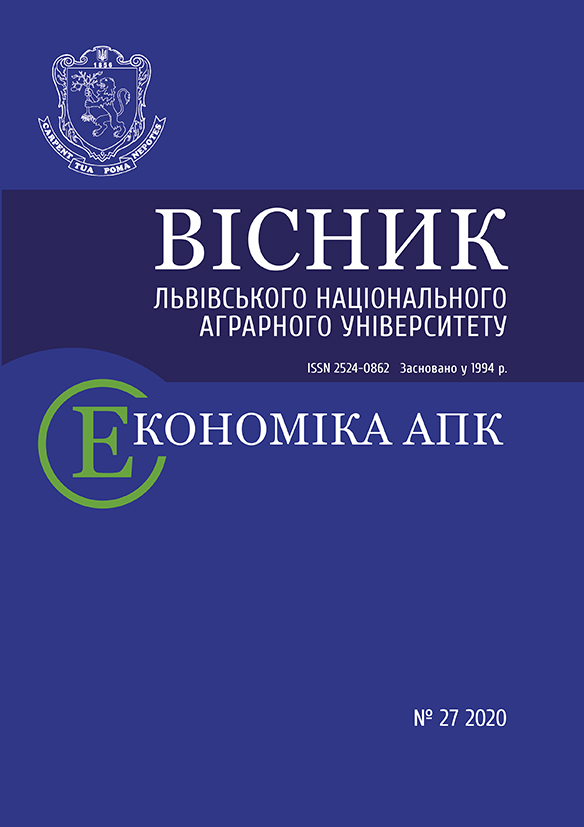Visnyk LNAU: Economics of AIC 2020 №27: 92-96
Introduction of the NSFR ratio into the practice of functioning of commercial banking structures
Hrudzevych Y., Ph.D.,
Shmatkovska T., Ph.D.,
Borysiuk O., Ph.D.
Lesya Ukrainka Eastern European National University
https://doi.org/10.31734/economics2020.27.092
Annotation
The article highlights the features of ensuring the liquidity of commercial banks according to classical methods and taking into account the need to move to new liquidity ratios recommended by the Basel III agreement - LCR and NSFR. At the same time, the issue of the NSFR standard as a new indicator for banking practice was raised. It is determined that the introduction of standards and approaches to liquidity Basel III involves strengthening the requirements for the formation of liquid assets of banks and requires the use of new standards to control the stability of sources of financing of commercial banks to diversify and reduce the risk of banking operations in general.
It is investigated that implementation of the NSFR standard reduces the dependence of banks on short-term sources of funding and proposes to diversify the bank's liabilities by maturity and thus reduce the risk of funding, which will improve the structure of the bank's deposit portfolio.
Based on the recommendation of Moody’s experts, it is determined that the available stable financing depends on the stability of funding sources, taking into account the maturity of liabilities, and the required stable financing depends on the general liquidity characteristics and risks of the bank's active operations. In this case, the ASF and RSF ratios are assigned depending on the maturities of the liabilities and the residual value, respectively. At the same time, the NBU, as a regulator, may well exclude interdependent assets and liabilities from these ratios, which meet specific conditions.
It is determined that introduction of the NSFR ratio in banking practice will allow commercial banks to reduce financing risks by reorienting them to more stable sources, which will stabilize the bank's activities and risk in future periods. Moreover, introduction of the NSFR standard will allow banks to reduce lending and facilitate the concentration of their funds on available more profitable market operations, which will lead to a general differentiation of banking operations.
Key words
liquidity, liquidity ratios, LCR, NSFR
Link
- Barnhill , Schumacher L. Modeling correlated systemic bank liquidity risks. A guide to IMF stress testing. Methods and models / Li Ong. Washington, D.C.: International Monetary Fund, 2014. 630 p.
- Dziamulych M. I., Chyzh N. Ensuring the liquidity of banks in crisis. Economic Sciences. Accounting and Finance Series / Lutsk National Technical University. 2014. Issue 11(41). P. 53–58. [in Ukrainian]
- Dziamulych M. , Chyzh N. M. Features of introduction of the liquidity coverage ratio (LCR) in the activities of commercial banks. Economic Sciences. Accounting and Finance Series / Lutsk National Technical University. 2017. Issue 14 (53). P. 63–68. [in Ukrainian]
- Moody’s analytics. Modeling methodology. Net Stable Funding Ratio. URL: https://www.moodysanalytics.com/-/media/whitepaper/2015/2015-25-06-modeling-methodology-net-stable-funding-ratio.pdf (Last accessed: 15.06.2020).
- Shmatkovska T. O., Maksymchuk I. V. Improving the accounting and control of enterprise costs using computer software products. URL: http://www.rusnauka.com/35_OINBG_ 2010/Economics/ 55447.doc.htm. (Last accessed: 20.06.2020) (in Ukrainian).
- The National Bank introduces a new long-term liquidity ratio for banks – NSFR. National Bank of Ukraine. URL: https://bank.gov.ua/ua/news/all/natsionalniy-bank-zaprovadjuye-noviy-normativ-dovgostrokovoyi-likvidnosti-dlya-bankiv--nsfr (Last accessed:06.2020) [in Ukrainian]



